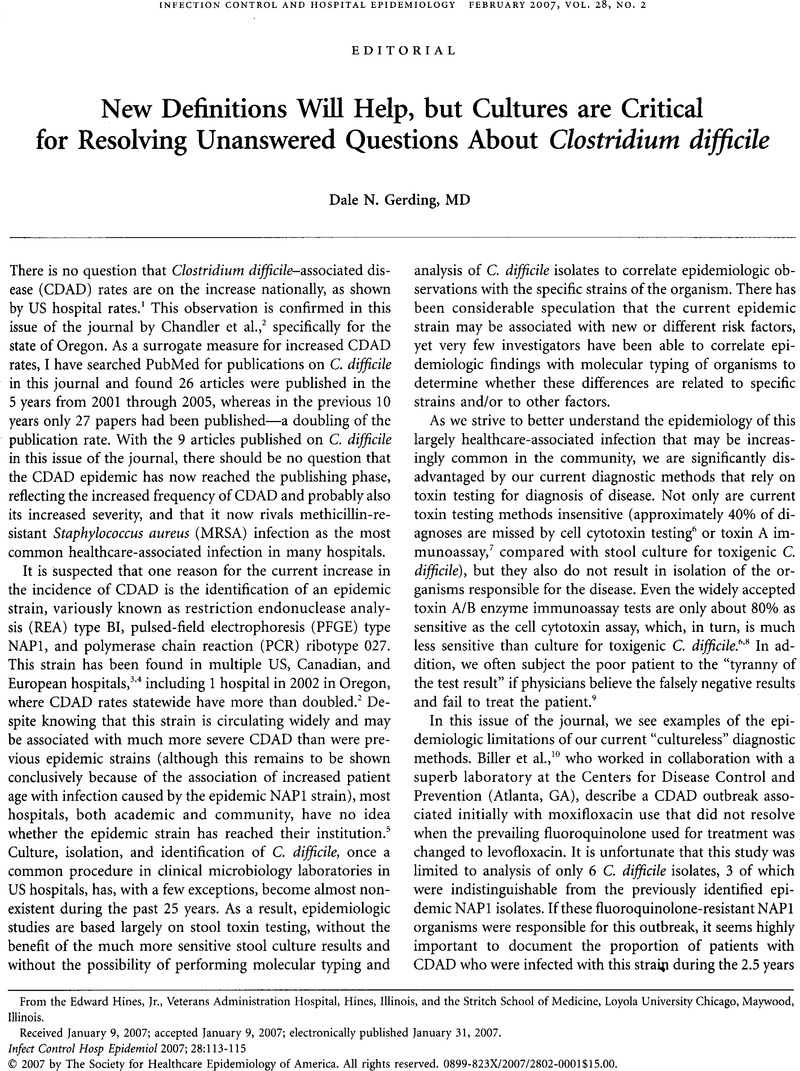Crossref Citations
This article has been cited by the following publications. This list is generated based on data provided by Crossref.
McFarland, L. V.
Clarridge, J. E.
Beneda, H. W.
and
Raugi, G. J.
2007.
Fluoroquinolone Use and Risk Factors for Clostridium difficile-Associated Disease within a Veterans Administration Health Care System.
Clinical Infectious Diseases,
Vol. 45,
Issue. 9,
p.
1141.
Owens, Robert C.
and
Valenti, August J.
2007.
Clostridium difficile-Associated Disease in the New Millennium.
Infectious Diseases in Clinical Practice,
Vol. 15,
Issue. 5,
p.
299.
Owens, Robert C.
Valenti, August J.
and
Wilcox, Mark H.
2007.
Antimicrobial Resistance: Problem Pathogens and Clinical Countermeasures.
p.
183.
Missaghi, Bayan
Valenti, August J.
and
Owens, Robert C.
2008.
Clostridium difficile infection: A critical overview.
Current Infectious Disease Reports,
Vol. 10,
Issue. 3,
McFarland, Lynne V
2008.
Update on the changing epidemiology of Clostridium difficile-associated disease.
Nature Clinical Practice Gastroenterology & Hepatology,
Vol. 5,
Issue. 1,
p.
40.
Bartlett, John G.
and
Gerding, Dale N.
2008.
Clinical Recognition and Diagnosis ofClostridium difficileInfection.
Clinical Infectious Diseases,
Vol. 46,
Issue. s1,
p.
S12.
Owens, Jr., Robert C.
Donskey, Curtis J.
Gaynes, Robert P.
Loo, Vivian G.
and
Muto, Carlene A.
2008.
Antimicrobial‐Associated Risk Factors forClostridium difficileInfection.
Clinical Infectious Diseases,
Vol. 46,
Issue. s1,
p.
S19.
Jaksic, A. Sasha
Nimmo, Graeme R.
and
Dwyer, Brian W.
2009.
Laboratory diagnosis of Clostridium difficile-associated diarrhoea: microbiologists (should) do it with culture.
Pathology,
Vol. 41,
Issue. 2,
p.
187.
Nerandzic, Michelle M.
and
Donskey, Curtis J.
2009.
Effective and Reduced-Cost Modified Selective Medium for Isolation of
Clostridium difficile
.
Journal of Clinical Microbiology,
Vol. 47,
Issue. 2,
p.
397.
Fraser, Thomas G.
Fatica, Cynthia
and
Gordon, Steven M.
2009.
Necessary but Not Sufficient: A Comparison of Surveillance Definitions of Clostridium difficile–Associated Diarrhea.
Infection Control & Hospital Epidemiology,
Vol. 30,
Issue. 4,
p.
377.
Jackson-Rosario, Sarah
Cowart, Darin
Myers, Andrew
Tarrien, Rebecca
Levine, Rodney L.
Scott, Robert A.
and
Self, William Thomas
2009.
Auranofin disrupts selenium metabolism in Clostridium difficile by forming a stable Au–Se adduct.
JBIC Journal of Biological Inorganic Chemistry,
Vol. 14,
Issue. 4,
p.
507.
Litvin, Marina
Reske, Kimberly A.
Mayfield, Jennie
McMullen, Kathleen M.
Georgantopoulos, Peter
Copper, Susan
Hoppe-Bauer, Joan E.
Fraser, Victoria J.
Warren, David K.
and
Dubberke, Erik R.
2009.
Identification of a Pseudo-Outbreak ofClostridium difficileInfection (CDI) and the Effect of Repeated Testing, Sensitivity, and Specificity on Perceived Prevalence of CDI.
Infection Control & Hospital Epidemiology,
Vol. 30,
Issue. 12,
p.
1166.
Bruns, A. H. W.
Oosterheert, J. J.
Kuijper, E. J.
Lammers, J. W. J.
Thijsen, S.
Troelstra, A.
and
Hoepelman, A. I. M.
2010.
Impact of different empirical antibiotic treatment regimens for community-acquired pneumonia on the emergence of Clostridium difficile.
Journal of Antimicrobial Chemotherapy,
Vol. 65,
Issue. 11,
p.
2464.
Perry, John D.
Asir, Kerry
Halimi, Diane
Orenga, Sylvain
Dale, Joanne
Payne, Michelle
Carlton, Ruth
Evans, Jim
and
Gould, F. Kate
2010.
Evaluation of a Chromogenic Culture Medium for Isolation of
Clostridium difficile
within 24 Hours
.
Journal of Clinical Microbiology,
Vol. 48,
Issue. 11,
p.
3852.



